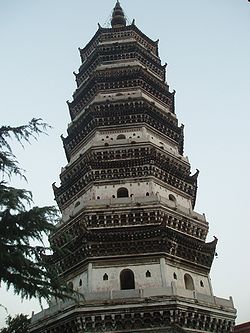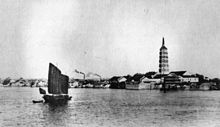The Zhenfeng Pagoda (simplified Chinese: 振风塔; traditional Chinese: 振風塔; pinyin: Zhènfēng Tǎ) in Anqing City, Anhui Province, People's Republic of China, is a Buddhist pagoda originally built in 1570 during the late Ming Dynasty. Due to its location near a bend in the Yangtze River, the pagoda was formerly used as a lighthouse, and contains niches for lanterns.[1] After construction, the pagoda was initially called the "Ten-thousand Buddha" (万佛塔) pagoda due to its interior containing over six hundred Buddha statues.[2]


Structure
editBuilt of brick and 72 metres (236 ft) tall, each of the pagoda's seven stories has seven corners, thereby creating a heptagon. Above the windows on each floor are a set of flying eaves. From the first to the sixth floor, arched doorways lead to an outside balcony. A total of 168 stairs inside the pagoda allow access to the top floor. The walls are tapered slightly, shaping the structure into a partial cone.[2]
References
edit- ^ "Zhenfeng Pagoda in Anqing of Anhui Province". china.org.cn. Archived from the original on 2016-03-03. Retrieved 2008-10-13.
- ^ a b Xu, Xiaoyong (2007). Design of Ancient Chinese Pagodas (中国古塔造型) (in Chinese). Beijing: Chinese Forest Press. p. 147"
30°30′13″N 117°02′57″E / 30.503596°N 117.04926°E